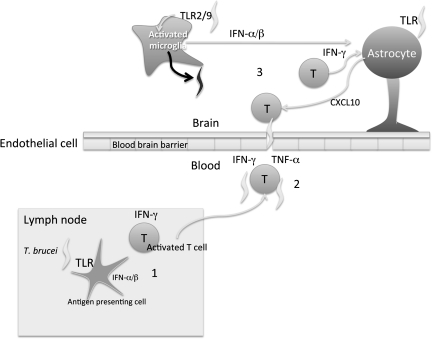Figure 7.
Model of Toll-like receptor (TLR)/MyD88 regulation of cerebral T-cell infiltration and parasite load in the brains of Trypanosoma brucei–infected mice. In an initial phase T. brucei–specific CD4+ and CD8+ lymphocytes are activated in secondary lymphoid organs in a TLR2 and TLR9 and MyD88-dependent manner (1). Interferon (IFN) α/β might participate in T-cell activation via dendritic cell (DC) activation. Activated T cells will subsequently invade the central nervous system (CNS) in a manner dependent on tumor necrosis factor α (TNF-α), IFN-γ, and IFN-α/β. Infection-induced MyD88 signals stimulate TNF-α secretion that mediates the expression of adhesion molecules on brain endothelial cells. Parasites probably follow T cells in penetration into the brain (2). Once in the CNS, T cells will probably contribute to signs of disease. TLR will induce IFN-α/β expression that, together with IFN-γ, will stimulate CXCL10 secretion by astrocytes, resulting in further recruitment of T cells and parasites into the brain [10]. In the brain, TLR2 and TLR9 synergistically stimulate an innate immune control of parasite levels that does not require TNF-α or IFN-α/β (3).

